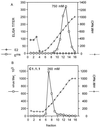Passage of classical swine fever virus in cultured swine kidney cells selects virus variants that bind to heparan sulfate due to a single amino acid change in envelope protein E(rns)
- PMID: 11000226
- PMCID: PMC112386
- DOI: 10.1128/jvi.74.20.9553-9561.2000
Passage of classical swine fever virus in cultured swine kidney cells selects virus variants that bind to heparan sulfate due to a single amino acid change in envelope protein E(rns)
Abstract
Infection of cells with Classical swine fever virus (CSFV) is mediated by the interaction of envelope glycoprotein E(rns) and E2 with the cell surface. In this report we studied the role of the cell surface glycoaminoglycans (GAGs), chondroitin sulfates A, B, and C (CS-A, -B, and -C), and heparan sulfate (HS) in the initial binding of CSFV strain Brescia to cells. Removal of HS from the surface of swine kidney cells (SK6) by heparinase I treatment almost completely abolished infection of these cells with virus that was extensively passaged in swine kidney cells before it was cloned (clone C1.1.1). Infection with C1.1.1 was inhibited completely by heparin (a GAG chemically related to HS but sulfated to a higher extent) and by dextran sulfate (an artificial highly sulfated polysaccharide), whereas HS and CS-A, -B, and -C were unable to inhibit infection. Bound C1.1.1 virus particles were released from the cell surface by treatment with heparin. Furthermore, C1.1.1 virus particles and CSFV E(rns) purified from insect cells bound to immobilized heparin, whereas purified CSFV E2 did not. These results indicate that initial binding of this virus clone is accomplished by the interaction of E(rns) with cell surface HS. In contrast, infection of SK6 cells with virus clones isolated from the blood of an infected pig and minimally passaged in SK6 cells was not affected by heparinase I treatment of cells and the addition of heparin to the medium. However, after one additional round of amplification in SK6 cells, infection with these virus clones was affected by heparinase I treatment and heparin. Sequence analysis of the E(rns) genes of these virus clones before and after amplification in SK6 cells showed that passage in SK6 cells resulted in a change of an Ser residue to an Arg residue in the C terminus of E(rns) (amino acid 476 in the polyprotein of CSFV). Replacement of the E(rns) gene of an infectious DNA copy of C1.1.1 with the E(rns) genes of these virus variants proved that acquisition of this Arg was sufficient to alter an HS-independent virus to a virus that uses HS as an E(rns) receptor.
Figures






References
-
- Anonymous. Current protocols in molecular biology: a laboratory manual. 3, suppl. 27. New York, N.Y: John Wiley & Sons, Inc.; 1994.
-
- Becher P, Shannon A D, Tautz N, Thiel H-J. Molecular characterization of border disease virus, a pestivirus from sheep. Virology. 1994;198:542–551. - PubMed
-
- Carbrey E A, Stewart W C, Kresse J L, Snijder M L. Natural infection of pigs with bovine diarrhoea virus and its differential diagnosis from hog cholera. J Am Vet Med Assoc. 1976;169:1217–1219. - PubMed
MeSH terms
Substances
LinkOut - more resources
Full Text Sources
Other Literature Sources

